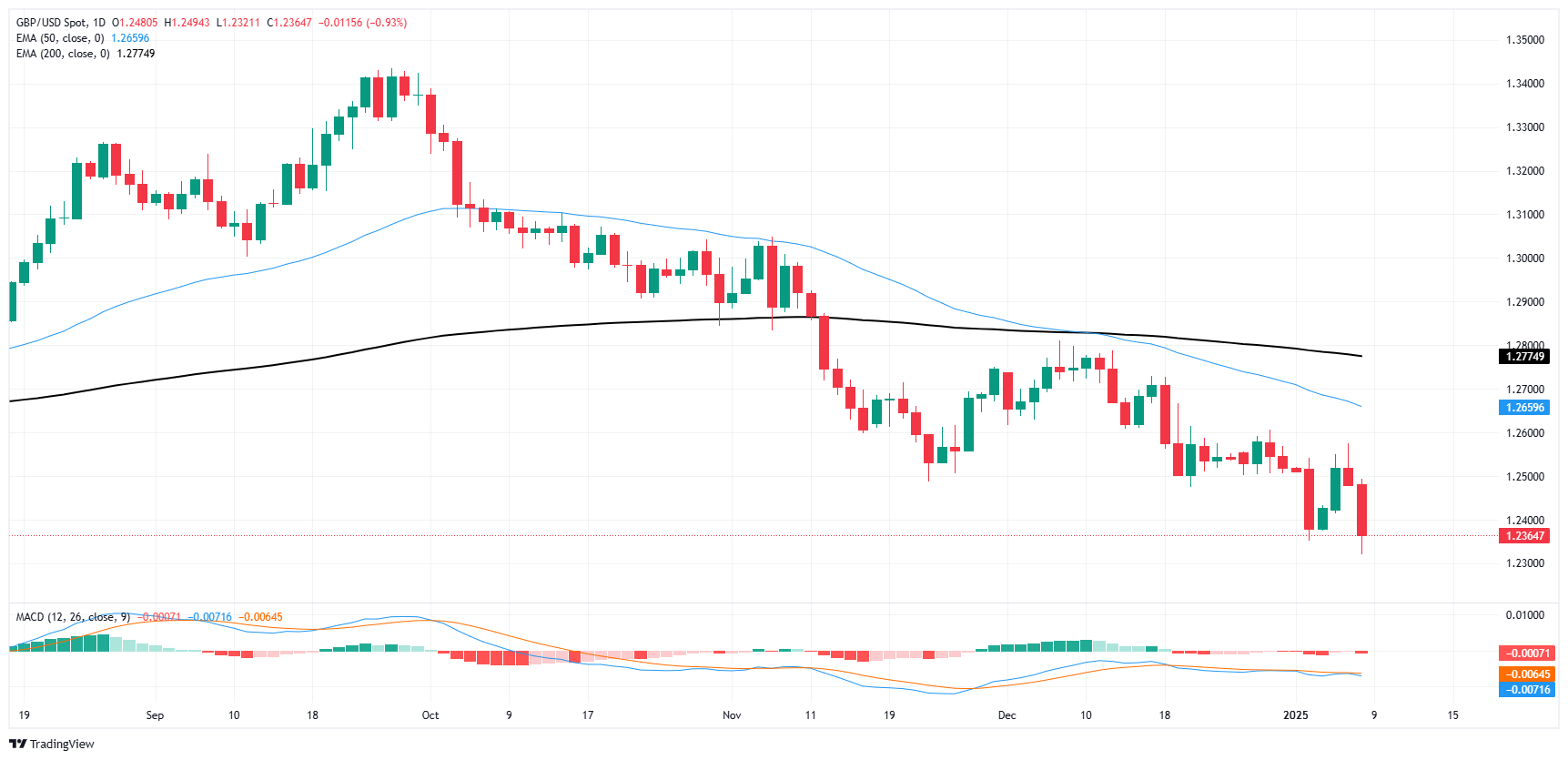- GBP/USD fell more than 0.9% on Wednesday as market sentiment weakens.
- A thin data schedule on the UK side leaves Cable operators facing looming NFP figures.
- The Fed may be more concerned about government policy than previously believed.
GBP/USD sank almost a full percentage point on Wednesday, moving away from the 1.2500 level that is proving too difficult for British pound bidders to recover. The pair briefly tested below 1.2350, and the Cable is set for a further decline towards multi-month lows.
The absence of significant economic data on the UK side is a constant in the first full trading week of 2025. Cable traders will remain exposed to the general market flows into and out of the US Dollar as they prepare for an end of hectic week. A series of speeches from Federal Reserve policymakers await traders on Thursday, as well as Challenger job cuts for December, which will serve as the latest preview of nonfarm payrolls data. (NFP) ahead of Friday’s jobs report.
On Wednesday, ADP’s Employment Change report indicated a slower-than-anticipated hiring rate for December, with a total of 122,000 jobs added compared to the expected 140,000 and 146,000 in November. Additionally, ADP wage data showed its slowest growth since mid-2021.
On the same day, the latest Federal Reserve meeting minutes revealed that policymakers may be more concerned about President Donald Trump’s proposed tariffs than previously thought. In recent weeks, Fed officials had downplayed the possible effects of immigration and trade policies on their decisions, but the recent policy meeting included four discussions about significant changes in US policy that could profoundly affect to the central bank. Additionally, the Fed reached a consensus that it was time to reduce the speed of rate cuts, underscoring that political uncertainty plays a crucial role in its reduced expectations of fewer rate cuts in 2025 than the market had previously anticipated. .
GBP/USD Price Forecast
GBP/USD briefly tested a new nine-month low at 1.2321 on Wednesday before a mid-term rebound later in the day, pushing the pair back above 1.2350. January trading has just begun, but the Cable is already on track to close in the red for the fourth consecutive month. A technical floor is set at the 1.2300 price level thanks to a sharp drop and reversal at the key level in April.
GBP/USD Daily Chart
British Pound FAQs
The British Pound (GBP) is the oldest currency in the world (AD 886) and the official currency of the United Kingdom. It is the fourth most traded foreign exchange (FX) unit in the world, accounting for 12% of all transactions, averaging $630 billion a day, according to 2022 data. Its key trading pairs are GBP/ USD, which represents 11% of FX, GBP/JPY (3%) and EUR/GBP (2%). The British Pound is issued by the Bank of England (BoE).
The most important factor influencing the value of the Pound Sterling is the monetary policy decided by the Bank of England. The Bank of England bases its decisions on whether it has achieved its main objective of “price stability” – a constant inflation rate of around 2%. Its main tool to achieve this is the adjustment of interest rates. When inflation is too high, the Bank of England will try to control it by raising interest rates, making it more expensive for people and businesses to access credit. This is generally positive for sterling, as higher interest rates make the UK a more attractive place for global investors to invest their money. When inflation falls too much it is a sign that economic growth is slowing. In this scenario, the Bank of England will consider lowering interest rates to make credit cheaper, so that companies will take on more debt to invest in projects that generate growth.
The data released measures the health of the economy and may affect the value of the pound. Indicators such as GDP, manufacturing and services PMIs and employment can influence the direction of the Pound.
Another important data that is published and affects the British Pound is the trade balance. This indicator measures the difference between what a country earns from its exports and what it spends on imports during a given period. If a country produces highly in-demand export products, its currency will benefit exclusively from the additional demand created by foreign buyers seeking to purchase those goods. Therefore, a positive net trade balance strengthens a currency and vice versa in the case of a negative balance.
Source: Fx Street
I am Joshua Winder, a senior-level journalist and editor at World Stock Market. I specialize in covering news related to the stock market and economic trends. With more than 8 years of experience in this field, I have become an expert in financial reporting.







